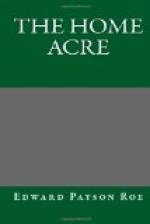Within recent years a third step forward has been taken. Some localities and soils were so unsuited to the raspberry that no variety containing even a small percentage of the foreign element could thrive. This fact led fruit-growers to give still closer attention to our native species. Wild bushes were found here and there which gave fruit of such good quality and in such large quantities that they were deemed well worthy of cultivation. Many of these wild specimens accepted cultivation gratefully, and showed such marked improvement that they were heralded over the land as of wonderful and surpassing value. Some of these pure, unmixed varieties of our native species (Rubus strigosus) have obtained a wide celebrity; as, for instance, the Brandywine, Highland Hardy, and, best of all, the Turner. It should be distinctly understood, however, that, with the exception of the last-named kind, these native varieties are decidedly inferior to most of the foreign berries and their hybrids or crosses, like the Cuthbert and Marlboro. Thousands have been misled by their praise, and have planted them when they might just as easily have grown far better kinds. I suppose that many wealthy persons in the latitudes of New York and Boston have told their gardeners (or more probably were told by them): “We do not wish any of those wild kinds. Brinckle’s Orange, Franconia, and the Antwerp are good enough for us.” So they should be, for they are the best; but they are all foreign varieties, and scarcely will live at all, much less be productive, in wide areas of the country.
I trust that this preliminary discussion in regard to red raspberries will prepare the way for the advice to follow, and enable the proprietor of the Home Acre to act intelligently. Sensible men do not like to be told, “You cannot do this, and must not do that”—in other words, to be met the moment they step into their gardens by the arbitrary dictum of A, B, or C. They wish to unite with Nature in producing certain results. Understanding her simple laws, they work hopefully, confidently; and they cannot be imposed upon by those who either wittingly or unwittingly give bad advice. Having explained the natural principles on which I base my directions, I can expect the reader to follow each step with the prospect of success and enjoyment much enhanced.
The question first arising is, What shall we plant? As before, I shall give the selection of eminent authorities, then suggest to the reader the restrictions under which he should make a choice for his own peculiar soil and climate.
Dr. F. M. Hexamer, the well-known editor of a leading horticultural journal, is recognized throughout the land as having few, if any, superiors in recent and practical acquaintance with small fruits. The following is his selection: “Cuthbert, Turner, and Marlboro.” The Hon. Marshall P. Wilder’s choice: “Brinckle’s Orange, Franconia, Cuthbert, Herstine, Shaffer.” The Hon. Norman J. Colman, Commissioner of Agriculture: “Turner, Marlboro, Cuthbert.” P. J. Berckmans, of Georgia: “Cuthbert, Hansel, Lost Rubies, Imperial Red.” A. S. Fuller: “Turner, Cuthbert, Hansel.”




